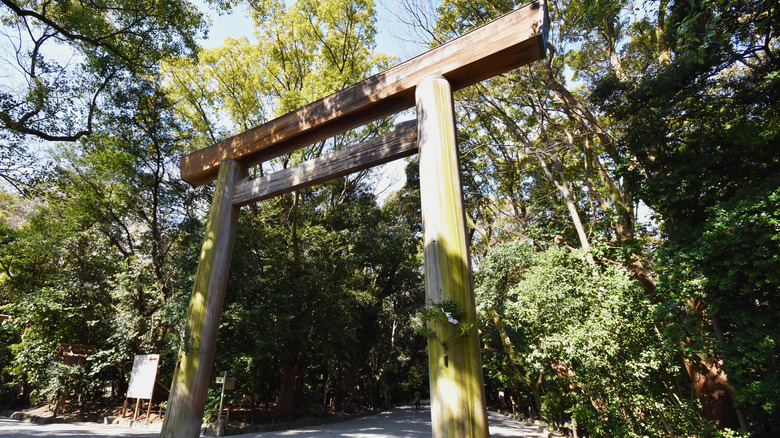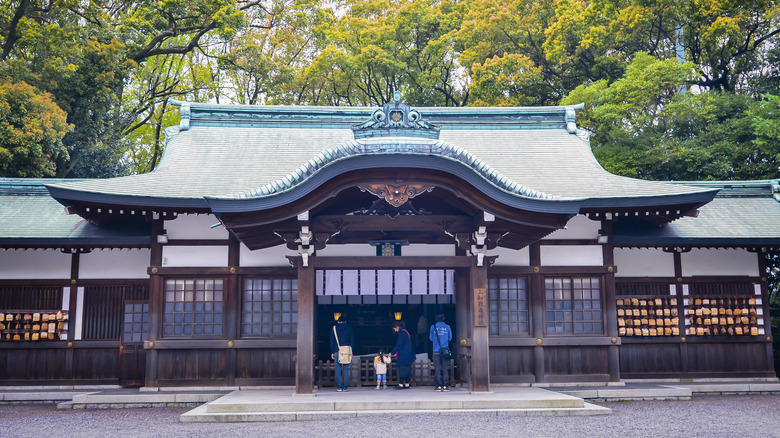Does The Legendary Kusanagi-No-Tsurugi Sword Actually Exist?
Across all of known history, there have been a handful of weapons that seemingly transcend time: King Arthur's famous sword Excalibur (via Britannica), or the Spear of Destiny, also known as the Holy Lance or the Lance of Longinus, that pierced the side of Jesus during the crucifixion. For whatever the reason, certain weapons grab our collective imaginations with their supposed power. Among them is Kusanagi-no-Tsurugi. A Japanese sword of mythic proportions, Kusanagi-no-Tsurugi, referred to as just the Kusanagi, is one of three important Japanese artifacts known as the Imperial Regalia (via All About Japan).
Originally known as Ame-no-Murakumo-no-Tsurugi, roughly translated as "Sword of the Gathering Clouds of Heaven," the Kusanagi was used to defeat a menacing eight-headed serpent (via Ancient Origins). With a little help from the god of sea and storms, Susanoo, the eight-headed dragon was defeated with the Kusanagi impaled into the tail of the magnificent beast. There the Kusanagi remained until it was noticed by Susanoo some time later (via Kokugakuin University). Susanoo removed the sword and presented it to the Sun Goddess, Amaterasu Omikami (via Britannica) who in turn gave the Kusanagi to her grandson Ninigi when he descended from the heavens to rule over Earth (via Britannica). Ninigi, with sword in hand, would go on to establish the first Imperial house in Japan, the Yamato clan (via Britannica), as well as eventually siring the first emperor of Japan, Jimmu.
History or legend?
Over the millennia, the Kusanagi has been handed down, enshrined in and out of the Imperial Temple until about the 2nd century A.D. Yamato Takeru, son of emperor Keikō, was allegedly one of the last to wield the legendary weapon. Using the sword to defeat a rival who set fire to a patch of dry grass around Takeru, Takeru used the mythical weapon to cut down the flaming grass, giving the sword a new name, from Ame-no-Murakumo-no-Tsurugi, to Kusanagi-no-Tsurugi — "grass cutter sword" (via Gizmodo). In a decision that would prove to be the death of him, Yamato Takeru left the Kusanagi behind on his way to fight a god living on Mt. Ibuki. Losing the battle, and his life, Takeru unfortunately also lost possession of the mythical sword.
The Kusanagi was rumored to have been involved in the death of the Emperor Temmu, some 600 years later in 686 A.D. According to Gizmodo, in the 12th century, the Kusanagi was allegedly lost in a sea battle where it was unceremoniously tossed into the ocean by a soldier trying to rid the world of the weapon. A duplicate of the Kusanagi has held vigil in the Atsuta shrine since that day, waiting perhaps for eternity, for its predecessor to return.
Handed down through the ages?
Which brings the question: Did the mythical sword actually exist? Did Kusanagi-no-Tsurugi wreak the damage it's believed to have wrought? Or is the supposed duplicate located in the Atsuta shrine not a duplicate at all?
The answer is as mythical as the sword itself. Most historians seem to agree that at some point the sword did exist (via 1066). As to its continued existence today, that remains a matter of great debate. According to Gizmodo, the duplicate of the Kusanagi, held at Atsuta Shrine along with two other mythical items that make up the Imperial Regalia of Japan, was given to the Japanese emperor Akihito in 1990 when he officially ascended to the throne (via History). And while Akihito received the Kusanagi as a gift for his ascension, the sword (as it has been for almost a millennia now) never saw the light of day.


